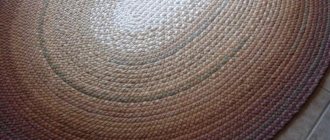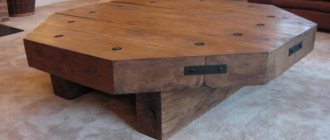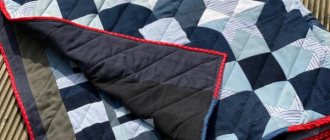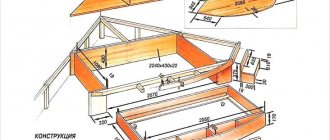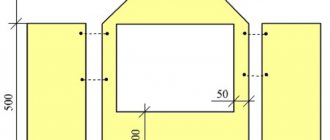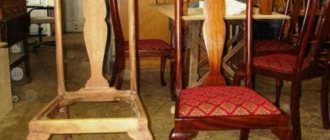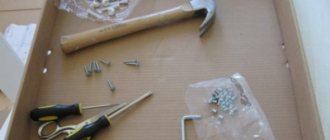A fun and useful hobby
There are many ways to make them; accordingly, these items are infinitely varied and can take their rightful place in any part of the apartment, in the hallway or in the kitchen, in the nursery, bedroom, living room. Beginners should not be embarrassed by the lack of skills; many of the techniques are quite simple, the work is fascinating, and step-by-step instructions and many ideas suggested by the masters will help overcome difficulties.
The peculiarity of homemade rugs is that, as a rule, “waste” material is used to create them, thus, savings and recycling of unnecessary things become by-products of creativity.
Preparation of material
In home knitting, weaving, weaving, narrow strips are used, cut from outdated clothes, bedding, unnecessary scraps; any raw material will go into business and find its application. A rug made of knitwear or fine wool will be soft, warm, it is good for a nursery or bedroom, a harder texture is appropriate in the hallway, and a mat that absorbs moisture is more suitable for the bathroom.
Old sheets and towels are convenient; they are easier to cut into strips. First of all, clothes need to be rid of unnecessary details: cut off the top of a T-shirt above the armholes, cut off the belt, pockets, and rough seams from jeans. Wrinkled items must be ironed before processing. The thickness of the future product depends on the width of the cut.
If the tapes are too short, they are connected to each other. It is not recommended to tie with knots, it is inconvenient to work with and looks sloppy. In order for rag rugs to have an aesthetic appearance, the connection must be inconspicuous.
Stitching with a needle takes a lot of time, but there is an excellent technique: cut slits at the places to be joined, lay one on top of the other, thread the end of the strip into the common hole and pull it out.
Materials and tools
There is no need to try to be original in choosing materials. The best crocheted home rugs are made from old cotton T-shirts.
It is recommended to choose items that are not too faded and contain more than 70% cotton and other natural fibers.
In the future, the rug made from them will be easy to wash and maintain in order. In addition, to make dense and lightweight mats for chairs or benches, you can use old nylon or knitted plain tights.
The list of necessary tools will not be long either. The following materials and tools will be useful during the work process.
- Largest hook size : from 6 to 10 mm. It is better to choose a one-sided option with a comfortable non-slip handle.
- Scissors . They will be needed to make fabric ribbons. You need to cut the material into strips 3-5 cm wide.
- Thread and needle . Needed to connect disparate tapes together. They can be replaced with a sewing machine: this way, creating a single ball will be much easier and simpler.
Having carefully prepared all the materials and tools, you should choose a comfortable workplace. Knitting a voluminous product is a rather labor-intensive and tedious task. That is why you should take care of choosing a comfortable chair in which you can spend more than one hour.
To prevent the ball from rolling away, it is better to put it in a basket or bucket, placing it next to it. This will prevent the thread from getting tangled during the process.
The good old way - knitting
The classic option is a small round rug for the hallway, kitchen, balcony, crocheted from scrap materials in a large size. Made in a circle, from the middle, such a thing looks good with almost any choice of fabric and creates a feeling of home comfort.
Begin knitting with a chain connected into a ring. Most often, narrow stripes of color are alternated, choosing them by contrast or keeping them in the same range. The rectangular version can be made around the middle square or with a smooth cloth from one edge; such a rug can also be knitted on knitting needles, although this is less convenient.
Those who have at least a little knowledge of crochet will not have a question about how to knit rugs from rags turned into ribbons; this is done with ordinary double crochets or single crochets, in a circle, with additions in each row. Moreover, this can be a good training for beginners, since it is easier to master the techniques on large material than when practicing with thin yarn.
Recommendation: to ensure an even edge of the rectangle, it is not advisable to combine material of different thicknesses.
Note!
- DIY scrapbooking for beginners: what it is and how to do it. What you need to create a beautiful album or notebook (photo + video)
- How to make a craft with your own hands: what you can do with your own hands at home
DIY foam crafts: snowman, Christmas tree, sculptures, original figures with instructions (photo + video)
Products made from braids
Curling braids using a needle and pins is the simplest way to weave rugs from strips of fabric; it is useful for beginners to try it out. Three cuts of different colors are connected at the ends and begin to braid. The product is made up of one continuous braid, but it is inconvenient to weave strips that are too long.
Therefore, you will have to attach another tape each time as you work. The approximate suitable length is about half a meter, but the texture of the fabric, for example, matters (it’s easier to work with hard ones), in the process it will become clear which size is more convenient.
The next stage of weaving a rug from fabric strips, rolling the braid, can be started before it is completely ready. The tip of the tape is tucked in, secured on a flat surface and they begin to wind turn by turn in a spiral, forming a circle.
Each added turn is sewn to the previous one so that the product does not fall apart. This can be done as you fold, or pinned together first and stitched afterwards. If braids of equal length are laid out in a row, you will get a rectangular braided rug, in which case you will have to work hard to secure the free ends. The top side where the seams run will be the bottom and will be hidden under the lining needed for strength and shape retention.
Recommendation. If the weaving material is too thin to create the desired volume, the cuts can be made wide and folded in half.
Note!
Papier mache from egg trays, boxes, cassettes: the best ideas on what can be made from egg packaging
DIY vase: step-by-step photo instructions, master class for a beautiful and unusual craft
- Paintings from buttons, panels, appliques and compositions with your own hands: how to make flowers, a butterfly, a fish or a tree craft from buttons
Preparation of flaps
Depending on the chosen technique for making the rug, scraps of fabric of different sizes and shapes may be required. It is better to select and cut the required amount in advance so as not to be distracted while working.
Preparing long strips of fabric for knitting or weaving a product can cause some difficulties: sewing them together is a long and tedious job. And if you tie them in knots, the rug will turn out rough and sloppy. But there are ways to avoid this.
Cutting continuous tape
This method is used when preparing fabric strips from old clothes: T-shirts, turtlenecks, T-shirts and even tights.
Step 1.
We cut off the rough bottom seam, the cuff of the sleeve or the toe part of the tights. For a T-shirt or turtleneck, cut off the top part right below the armholes.
Trimming seams
Step 2.
Place the product on a flat surface with the side seam facing you and cut it into strips of the required width, without cutting a couple of centimeters to the opposite seam.
Cutting strips
Step 3.
Thus, we cut the entire workpiece into fringe.
Workpiece cutting
Step 4.
We straighten the workpiece so that we can see the entire uncut part, and cut it not in a straight line, but at an angle, directing the scissors from one slot to the adjacent one on the other side of the product.
Cutting fabric
As a result, we get a closed ring, which to obtain a tape you just need to cut across one of the seams.
Blank for making a rug
Blanks can be wound into balls
Connection without node
If the length of the tape is not enough or you need to connect many short pieces with each other, the simple technique shown below will help you do this.
| Image | Description |
| Step 1 | We cut small holes at the ends of adjacent strips that need to be connected. |
| Step 2 | Place the strips on top of each other, aligning the slots. |
| Step 3 | Pass the second end of the top strip through the slot from below and pull the entire strip through it. |
| Step 4 | Tighten the connection. If necessary, repeat these steps to further lengthen the tape. |
Advice. If scraps of fabrics of different thicknesses and densities are used, then thinner ones should be cut into strips of greater width to even out the thickness of the weaving.
Homespun rugs
The well-known weaving principle is also often used in the manufacture of homemade patchwork rugs. The role of the machine will be performed by a wooden frame, slightly larger in size than the intended canvas. Small nails are placed on the top and bottom strips at a distance of about 2 cm from each other, and a base is pulled over them from the same strips that were prepared for creating the canvas or from twine, which must be strong.
Its end is tied to the first upper nail, pulled to the parallel lower one, then to the second upper one, filling the space between the slats. The strips are pulled between the warp threads row by row, from time to time compacting what is collected with your hands or using a special wooden fork.People often ask: how to weave a rug without a loom? The frame will be successfully replaced by a large sheet of cardboard. The cuts on opposite sides will act as nails, holding the warp threads. Further actions are the same as with the usual method.
You can use a plastic hoop with deep notches for weaving, stretch the warp along the diameter and lay the material in a circle. The difficulty is to lay the threads strictly between opposite points so that they intersect exactly in the middle.
Corner rug
A small round or oval rug with an unusual scaly texture is very appropriate in the bedroom, hallway, or bathroom. Let's look at how to sew a grandma's rug from leftover fabric step by step.
Note!
Flowers made of wool (85 photos) - how to felt a flower from felt or a wool brooch. Step-by-step instructions for beginners
- What can be made from wool (95 photos): felting for beginners, master class, felting techniques
- How to weave a “Dragon Scales” bracelet from rubber bands on a machine: photo examples, weaving patterns
- Select rags of different colors and the same density.
- Prepare a round lining.
- Cut into squares, approximately 10 x 10 cm.
- Form corners from the blanks: fold each one diagonally, and the resulting triangle is folded in half again.
- Place the corners in a circle, in the middle of the future product, with the tips towards the center, pin or throw.
- When sewing on a typewriter along the bases of the corners.
- Place the next rows slightly overlapping and sew.
- Finish around the circumference with bias tape.
Some corner crafts resemble a lush open flower. How to sew a rug from triangular scraps to give it this look? To do this, the base of each part is folded like a petal and work begins from the edges, directing them with their tips from the center.
Patchwork
Although the name of this method appeared relatively recently, blankets sewn using this technology can be seen in any village house.
To get a beautiful carpet, you must follow the instructions exactly:
- Fabric preparation. It is advisable to take bright and beautiful pieces.
- If the fabric is old, then it needs to be ironed thoroughly.
- To ensure that the finished product does not deteriorate ahead of time, you should prepare the base and padding (batting or construction foam).
- Cut the prepared fabric into pieces of the same size, taking into account allowances.
- The flaps are laid out according to a pre-selected pattern. For the first time, it is better to choose a simple pattern.
- To give the finished product softness and volume, a spacer is placed between the base and the top fabric.
Patchwork
Rugs for children's rooms
One of the most original products of this kind is assembled from pompoms. Be sure to use filler - centipon or foam rubber, so the carpet turns out soft and warm, very cozy. The most suitable material is natural knitwear.
This is a good choice for those who are interested in how to make a rug with their own hands for a child. The base should be dense; we recommend using an old bedspread. Pompoms are made the same size, they can be quite large, more than 10 cm in diameter. The blanks for them are cut out according to one round template.
Each piece is stitched around the circumference by hand using a simple stitch. Place a lump of filler in the center, pull the fabric into a ball, and secure it with stitching. It is better not to sew the balls to the lining, but to attach them with a glue gun.
A fluffy rug resembles a small lawn, especially if done in green colors. The work is painstaking, but not complicated, it is performed on a mesh intended for carpet weaving, or construction mesh can be used.Cut strips of the same length (up to 12 cm), fold them in two, thread them into the meshes using a crochet hook so that the ends form “grass” and tie them in a knot. In this way, fill the entire prepared mesh.
Patchwork and grass rugs
Nowadays carpets with long pile, called “grass”, are fashionable. They are very soft and warm. True, it’s difficult to clean them without a powerful vacuum cleaner, but they look beautiful and cozy with them. Making such rugs with your own hands is not at all difficult, however, it can take a lot of time. This is if you decide to use threads. But it's very beautiful.
These are the results that can be obtained using this technique. But to make the carpet so beautiful, you need ribbon yarn or thick threads
The idea is outrageously simple: threads and strips of fabric are tied to a mesh base. There are two tying techniques - just using a knot, and making a loop. They give slightly different results, but both techniques are good. You can try and choose.
How to make rugs with your own hands from scraps
The same painting mesh is suitable as a base, but a rubber anti-slip backing for carpets is better. She's practically perfect. We tie threads or scraps of the same length to the cells of the grid - in each or through one.
Row by row we tie the scraps
If you do not have such perseverance, but you have a sewing machine, the process can be speeded up significantly. But the base must be woven. We fold “blade of grass to blade of grass” and stitch it on a typewriter. So row after row. Making patchwork rugs with your own hands is much faster with a machine.
You can also use a rubber mat with holes as a basis.
Patchwork - a classic of patchwork creativity
Making a patchwork rug requires a more careful selection of materials, and if a complex item is conceived, then considerable skill. This is the same technique used to make the famous “granny” quilts.
Since the product is intended for the floor, the fabric chosen is dense: denim, gabardine, drape or tweed from an old coat. You will need a lining made of solid fabric, also strong. If you have worn-out carpet, it will make an excellent base.
The design of the item needs to be thought out in advance, a combination of colors should be carefully selected, preferably bright ones, and one of the many designs developed in this area should be taken as a model. It is useful to familiarize yourself with what has been created by experienced craftsmen.
Many of the author's mosaic items are complex, exquisite, practically a master class. You will have to sew both by hand and by machine, because the amount of work is large.
To assemble a kind of mosaic, which is a rug made from scraps of fabric using the patchwork technique, first take into account all types of elements that make up the selected ornament. A paper template is made for each of them. To make and work with them, use:
- scissors;
- paper or cardboard;
- pencils;
- fabric chalk;
- pins.
Using templates, cut out the required number of parts, leaving seam allowances. Referring to the image of the finished product or your own conceived pattern, the ornament is laid out, sewn by hand, then by machine, ironing each seam.
Step-by-step master class on making your own rug from strips of fabric
There are a lot of ways and sketches by which you can knit your product, but sometimes it is not entirely clear in what sequence and by what method the piece of furniture was made. You can find many tutorials on the Internet that describe all the steps in detail. If watching the video is inconvenient, then you should consider in advance the main stages of carpet production.
Selection of materials
You can choose any material for needlework. Jeans, shirts, dresses, blankets will do. But for an accurate choice, it is better to know in advance for which specific room the rug is being knitted. If you need to decorate a bedroom, then a fluffy and soft material is ideal, but for the bathroom you will need a fabric that absorbs water well. In any case, the choice of material is free and limited only by the capabilities and availability of the required material.
Old clothes
Pattern
The dimensions of the product can be different and depend on the size of the room and your own imagination. You can take a closer look at the cutting technique using the example of a rug consisting of 20 round parts. First you need to make a parts template. If you don’t have a compass, you can use a plate or a pan lid. Using these tools, an even circle is drawn on the material and a circle is cut out along it.
Cutting details
The template is applied to scraps of fabric and 20 blanks are cut out from it. The same process is carried out with carpet insulation.
Sewing 20 round pieces
The parts are laid out one on top of the other - insulation on the bottom, the workpiece on top, face down. The resulting “sandwich” is fastened with pins along the entire circumference. Then an indent of 5 mm is made from the edge of the workpiece, and a seam is laid. To prevent the fabric from puffing up after turning it inside out, the seam allowances are notched. A wide cut is made at the edge of the sewn fabric, through which the part is turned out very carefully. The resulting flap is smoothed with an iron. All 20 circles are prepared using this method.
Assembling parts into a composition
A cardboard square is placed on each part so that its corners are in contact with the circle, and outlined with a pencil. The circles are folded in pairs, with the cuts inward, and stitched along the applied markings. Thus, 4 blanks are connected and stacked in a row.
They are pinned together and sewn together. The long sides of the resulting part are also sewn together with a continuous seam. These steps continue until you get a carpet with dimensions of 4 circles in width and 5 in length.
You might be interested in Beautiful patterns with beads and cross stitch for embroidering a unicorn
Additional Information! After all the parts are connected, they are carefully ironed in the steam mode, otherwise it will be uneven.
Firmware for petals
Each petal is applied evenly to the fabric and sewn with a neat seam. Only the slots made on the reverse side remain. You can ignore them, but it is better to process and sew them up by hand.
Master Class
Simple patchwork for beginners
At first, to master the techniques, it is better to perform a simple example. Usually the question does not arise of how to sew a rug from scraps if they are cut into identical rectangles or squares. Such parts are sewn into strips, which are then easily combined into a fabric if they are arranged in parallel or in a more complex order.
A popular technique is to form an ornament of long and short colored ribbons on the sides of a rectangle located in the center. A bright, motley picture is obtained from triangles. It is not difficult to simplify their shape for further work: if you connect them with long sides, you get a square, and if you connect them with short sides, then a strip.
Having learned to make simple rugs from scraps of fabric with their own hands, and over time, having gained experience, many passionate craftswomen create luxurious original works, real works of art.
Basic techniques
The rich imagination of the needlewoman alone is not enough for the work. It is necessary to master the techniques of performing the product:
- Knitting . For work, strips pre-knitted from natural wool are used.
- Patchwork . This is the easiest form of sewing. Using this technique, a mosaic is created from patches of different sizes.
- Weaving . This technique can use knitting needles, hooks, or the product is made without tools: the patches are woven into one fabric in a frame.
- Stitching . This technique uses spiral rings or round blanks that are sewn to dense fabric.
Photos of beautiful rugs made from scraps of fabric
Please repost
1+
